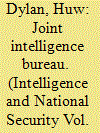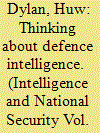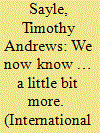| Srl | Item |
| 1 |
ID:
111181


|
|
|
|
|
| Publication |
2012.
|
| Summary/Abstract |
In 1946 veteran British intelligence officer Kenneth Strong undertook the Directorship of a new intelligence organization, the Joint Intelligence Bureau (JIB). The JIB absorbed the responsibilities of several wartime intelligence organs, and was responsible for economic, topographic, and aspects of scientific intelligence on an inter-service basis. Its responsibilities grew over the following 18 years; most notably, it absorbed atomic intelligence in 1957. When the Defence Intelligence Staff was created in 1964, absorbing the JIB and the individual Service agencies, JIB was at its heart and Kenneth Strong its first Director. The organization conducted key work in the early Cold War, was at the centre of an international network of Joint Intelligence Bureaux, and was an important stepping stone in the movement to centralize military and military-relevant intelligence in Britain - but the historiography pays it surprisingly little attention. This paper introduces the JIB and various aspects of its work, and demonstrates that its low profile in the historiography is unjustified.
|
|
|
|
|
|
|
|
|
|
|
|
|
|
|
|
| 2 |
ID:
147578


|
|
|
|
|
| Summary/Abstract |
The Defence Intelligence Staff’s closest relative was the Joint intelligence Bureau. The Bureau was created in 1946 as part of the post war reorganization of the intelligence machinery, consolidating a number of wartime organizations. It was a centralized organization, providing defence intelligence to customers in the armed forces and government. The Bureau was founded with the objective of implementing several lessons that had been identified in the Second World War concerning the organization and management of intelligence. This paper examines the particular lessons the Bureau’s founders and its leader had learned, and the ideas they sought to ingrain in the organization. It asks what kind of foundation the Bureau provided for the DIS, when it merged with the service intelligence directorates in 1964.
|
|
|
|
|
|
|
|
|
|
|
|
|
|
|
|
| 3 |
ID:
179859


|
|
|
|
|
| Summary/Abstract |
Igor Gouzenko’s defection might have been the first—and most famous—of the Cold War in Canada, but it was hardly the last. Recently opened after Access to Information Act requests made by the Canadian Foreign Intelligence History Project, a number of records cast brighter light on this aspect of Canada’s intelligence history. This article offers an overview of how the Government of Canada established its policy to manage defection and those who defected. It offers a number of possible leads for future research projects, some, but not all, of which, will require the release of further material, whether under the Access to Information Act or a broader declassification framework from the Government of Canada.
|
|
|
|
|
|
|
|
|
|
|
|
|
|
|
|